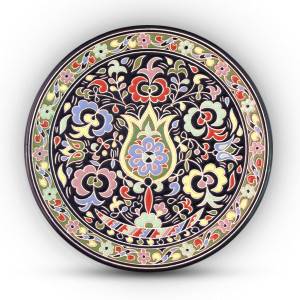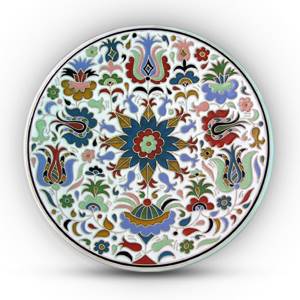The word "ceramics" comes from the Greek keramos, which means "clay". In the traditional sense, these are products obtained by sintering clay or a mixture of clays with various additives. This is an ancient art, born in prehistoric times, initially pursuing exclusively functional goals. As time passed, the properties and forms improved, the quality of the shard improved, and the skills of the artisans were honed. In addition, there was a desire for creativity. Make products unique, decorate them, form your own styles, reflecting the traditions, ways, culture and life of your social group. This is how ceramics become an artistic object. A legacy whose roots go back to the Earth and the fire given by Prometheus.
In Crimea, as well as throughout the world, ceramics have played a big role in people's lives since ancient times. Having emerged as an industry of utilitarian significance, it gradually acquired an aesthetic character. The dishes became decorations for the interiors of rich houses; finishing decorative ceramics, in particular tiles, turned from a simple expressive means of architecture into monumental art. Since ancient times, ornamental elements of Crimean craftsmen have played the role of a language capable of transmitting socially significant information. The ancient language of ornament is also used in modern works; it makes it possible to qualitatively and fully preserve and develop the cultural heritage of Crimea. The author's workshop “El-Cheber” (translated from the Crimean Tatar language as “country of masters”) by Rustem Skibin carefully preserves and develops traditional techniques for working with ceramics.
Rustem Skibin was born in 1976 in the city of Samarkand (Uzbekistan). In 1996 he graduated from the Samarkand School of Arts with a degree in artist-teacher. In the same year he returned to his homeland in Crimea. From 1996 to 2000 he worked as the chief artist at the Tavrika ceramics enterprise in Simferopol. Based on the ornaments of Crimean Tatar embroidery, collected and deciphered by the artist and art critic Mamut Churlu, Rustem Skibin created his own style of polychrome painting of ceramic products, which carries the best features of the traditional culture of the Crimean Tatars. The master has perfectly mastered the method of creating new versions of ancient ornamental structures each time. The patterns of his works carry powerful positive energy inherent in the main program of existence - the continuation of life on earth. He created a series of unique dishes with exquisite calligraphic compositions. The artist actively collects, analyzes, and restores manufacturing technologies for various forms of traditional household pottery ceramics, studies and restores professional vocabulary. The master constantly finds ways to use his craft to expand the range of products. In addition to the main product of ornamented dishes and plates, it produces ceramic lamps, fountains, musical instruments, and decorative panels. His works are popular far beyond the borders of Crimea. She teaches at the Bakhchisarai children's ceramic studio “Chelmekchiler” (translated from the Crimean Tatar language as “potters”). In the village of Akropolis (Simferopol district), he created the creative workshop “El-Cheber”, in which he trained such masters as Aider Abibulaev and Asie Mushurova. Skibin is an active participant in regional and international exhibitions. Rustem is a constant participant in seminars and exhibitions of the Crimean Style project. Member of the creative association “Chatyr-Dag” (named after a mountain in Crimea). Candidate member of the National Union of Folk Art Masters of Ukraine. Member of the Association of Crimean Tatar Artists.
“In the works of Rustem Skibin, symbols and signs are a visual image in which the memory of the people is encoded. In this sense, interesting are the symbols and signs related to the ethnic memory of the Crimean Tatar people, who were not divorced from universal knowledge, general knowledge of nature, knowledge of the intricacies of the human soul, and the magic of creativity. The range of symbols in the ornament is varied and multifaceted.
To decipher means to more fully understand what the master wants to say about spiritual life, about beauty, about significant events in the life of an ethnic group. A symbol, an ornament is an allegorical language of the soul, a figurative perception of the people. The selection of colors and combination of shades is a direct reflection of the lush Crimean nature and local landscape.”
Azime Kemalova
Young family

The family is one of the most important cells of society; children are born here, values are formed, experience is transferred, and learning takes place.
Young families who are just beginning to blossom and understand the happiness of family life bring special joy. The central symbol of the composition is the tulip; this flower in the art of the Crimean Tatars symbolizes a young man. Inside the tulip there is a rose - a sign of a woman. This combination of images of two seemingly different flowers personifies the unity of a guy and a girl, bound by bonds of love. At the base of the composition there is a boat, a symbol of path and movement. This sign carries the desire to overcome obstacles on the path of life and preserve family values throughout life. The flower fruits growing from the central sign are depicted as ripe, open, generously distributing their contents for the benefit of prosperity and well-being.
Protection
 “And We have commanded man to be kind to his parents and to take care of them, especially the mother, for the mother carries him in her womb, and her weakness increases as the child grows.”
“And We have commanded man to be kind to his parents and to take care of them, especially the mother, for the mother carries him in her womb, and her weakness increases as the child grows.”
(Surah Luqman, verse 14). Protection is one of the fundamental functions of men and boys who are responsible for their family and friends. The rose, located in the center of the composition, denotes a woman-mother - a source of warmth, love, kindness and mercy, a teacher of future generations, a bearer of the traditions of the family and people. The sun-shaped rosette around the rose consists of a group of stylized tulips. This flower in the ornament of the Crimean Tatars symbolizes a young man. In this composition, images of tulips form a circle, meaning protection and care for the woman-mother, whose sign is in the center of the circle. The entire ornament is based on a triangle located at the base of the composition, which in the traditional Crimean Tatar ornament symbolizes the earth, the basis of existence. A vessel resting on a triangle signifies a house. The image of a tulip with lush petals, located at the top of the composition, personifies the head of the family, father and husband. The many flowers blooming on the branches of the tree carry wishes for the development of strength, courage and masculinity in the younger generation.
In Crimea, at all times, special attention was paid to ceramics.
For example, during the Ottoman Crimea, pottery was regarded as the ruling class of production, essential to ensuring the well-being of all subjects of the empire. The Ottoman state recognized the need to maintain market saturation with pottery. Also during the Ottoman Empire, trade in ceramic products with other states can be traced, therefore, the import and export of clay products was carried out. From ancient times to the present day, ceramic products have occupied one of the leading places in the decorative and applied arts of all peoples of the world. Museums in different countries house many masterpieces of ceramic art. From primitive vessels, fashioned by hand and fired at the stake, to products made based on the latest achievements of modern science; from rough brick to fine transparent porcelain - this is the path of ceramics.
Based on materials from the site https://www.el-cheber.com
